How engagement rings are made
Learn every step of how a diamond ring is made
Ringspo is reader supported
Ringspo is reader-supported, which means we may receive a commission if you click a link to a retailer & subsequently make a purchase.
We feature links to several retailers to help readers find the one that is the best fit for them. Find out more about how Ringspo works here.
After Mythbusters and anything with sharks in it (obviously..), ‘How It’s Made’ is my favourite show on the Discovery Channel. From candy canes to car doors, bowling balls to bassoons, ask me about pretty much anything and I can tell you how it’s made.
In this spirit of discovery, we’re going to take a look at how one of my recommended retailers, crafts its engagement rings. This is a sponsored post and I could have chosen any topic, but felt that it would make an extremely interesting post as I hadn’t seen this information anywhere else online.
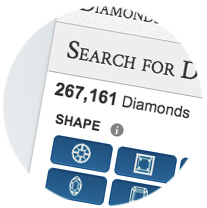
Blue Nile can have over 250,000 diamonds and 300 different setting styles available through their online store at any one time which means that there are millions of different possible combinations available. The exact number of variations of ring is difficult to calculate, but there are around 75 million different rings that could, in theory, be produced. With such variation, it should be possible to find an engagement ring that is perfect for everyone.
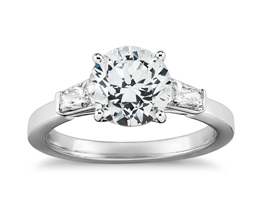
But how are they actually made? Are they mass-produced in a sterile factory, with staff in white suits and face masks watching robots pump out rings like they were the latest iPhone? Or are they carefully crafted in a Santa Claus-like workshop, with aproned artisans taking great care as they carefully craft each and every ring?
Blue Nile were good enough to talk me through their ring creation process and I found that it was definitely much closer towards the latter. Each ring has the utmost care taken in its creation, to reflect the important role that it is just about to play in a couple’s life.
Read on to see how an engagement ring is actually created.
The Diamond
The first thing that happens when the ‘buy’ button is clicked is that the different parts of the ring need to be brought together to be assembled. The ring band, the ring head, the center stone and any other diamonds that will be used in the setting may all come from different suppliers. In the US, this is at Blue Nile’s headquarters in Seattle, while in Europe it is in Dublin and in Asia it’s in Shanghai.
When a diamond is chosen from the online search tool, the stone is selected from the in-house inventory or alternatively shipped to a Blue Nile production facility from a diamond supplier.
Blue Nile has a network of trusted suppliers across the country who hold diamonds on their behalf until a sale is made. This means that Blue Nile doesn’t have to hold what could potentially be hundreds of millions of dollars worth of diamond stock, with all the investment in purchasing a large inventory and security that this would entail. Reducing overheads in this way means that Blue Nile can provide high quality diamonds at extremely competitive prices.
Some of the diamonds in Blue Nile’s inventory are offered by other retailers at the same time – they share this ‘virtual inventory’. However, the prices that shared inventory diamonds can be offered at can vary hugely. Check out this blog post, which shows that mall jewelers Kay and Zales can charge up to twice as much for the exact same diamonds as my recommended retailers.
Blue Nile does keep a small inventory of diamonds in house, including their ‘Astor By Blue Nile’ diamonds, which have been selected because their cut grade is within very tight parameters to give the most brilliant sparkle possible.
When the diamond is received it is given a quality check by one of Blue Nile’s in-house gemologists, where it is checked to ensure that it matches the grading certificate that is supplied with it, that it’s in perfect condition and that it’s ready to be mounted.
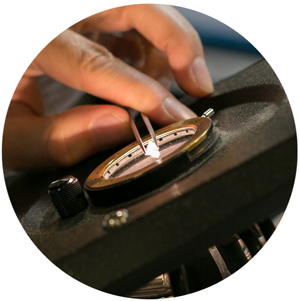
Each diamond is then carefully polished before being sent to a bench jeweler to be united with its ring setting
The Setting
Blue Nile’s ring settings are created by craftsmen at several suppliers, depending on the type of ring. There are three ways that engagement ring settings are created:
The settings for ‘Build your own’ rings, where the diamond is chosen separately from the setting, are mostly cast. Molten metal is poured into a mold and then plunged into cold water to cool it instantly.
Several rings are cast at once, then separated and the rough edges filed away, before the ring is polished and shaped:
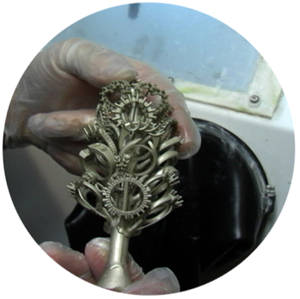
The heads of solitaire settings are often ‘die struck’, as this gives great strength which is needed to ensure that the prongs that hold a center stone in place do not bend.
Die striking involves pressing precious metal between two hardened steel plates which have cut outs in the desired shape. The advantage of die striking is that it produces incredibly strong and dense metal. However, it is difficult to create more intricate designs with die striking, which is why it isn’t used for all shapes.
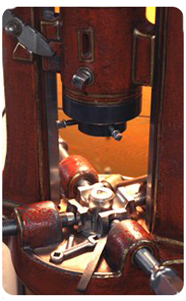
For simpler shapes e.g. plain wedding bands, rings are milled.
A tube of metal is rotated on a milling machine and and excess metal is trimmed away, before the ring is cut off at the correct width. If you ever made a table leg in woodshop at school, it’s kind of like that! [/two_third]
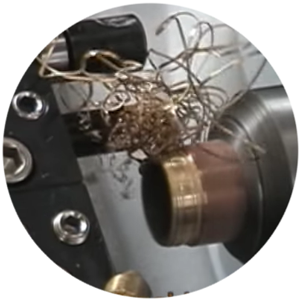
Building The Ring
When the diamond and the different parts of the ring are brought together, they are thoroughly inspected to ensure that they meet Blue Nile’s rigorous quality standards. Following this inspection, each of the the individual parts are passed to a jeweler who begins the build process.
The first stage of the build is to resize the ring band to the correct size. It’s easier to make a ring smaller than it is to make a ring larger, so resizing usually involves removing some of the metal from the band, then joining it up and polishing it so that the join cannot be seen.
Once the resizing has been completed, the band is then paired to a ring head – the style of ring head depends on the style of the ring setting chosen, whether that’s a solitaire, halo, three stone ring or any other style.
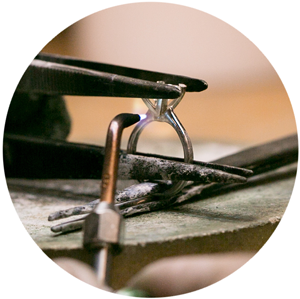
The ring head is attached to the band by soldering it using a small oxyacetaylane torch – a delicate process as the welds need to be extremely neat.
Once the ring setting has been completed, the ring is passed to specialist jewelers known as setters. Setters are usually the most experienced craftsmen in any workshop due to the time it takes to master the art. Setting is tremendously important because if a center stone isn’t set correctly it could come loose and be lost, which would be devastating. On average, Blue Nile’s diamond setters have 20 years of experience.
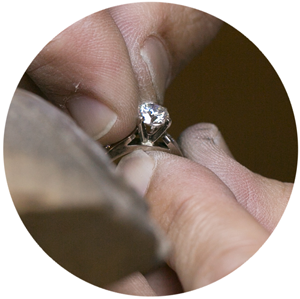
The setter cuts tiny notches into the ring head that the center stone will sit in, known as ‘seats’ and then mounts the diamond in the setting.
The seats need to match the individual diamond exactly to ensure that the stone will be held securely in place.
Once the diamond is seated in the setting, the prongs are bent into place around the diamond, to ensure that it is held securely and cannot move.
Tip: It’s a good idea to get your engagement ring checked by a jeweler every 6-12 months to check that the center stone is still held securely. During day-to-day wear, prongs can get snagged on clothing and bent slightly out of position which can mean that a center stone can become loose.
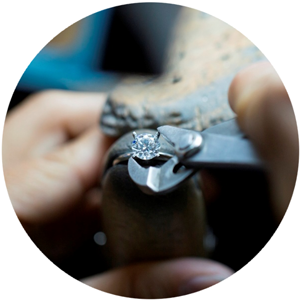
After the diamond is mounted, the ring is inspected by quality assurance again to ensure it meets quality standards. If a ring has micropave diamonds, each of these are tested individually to ensure that they are held securely and will not come loose.
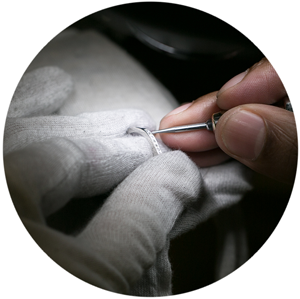
The size of the ring band is double-checked to ensure that it has not become distorted in the setting process and that it is still perfectly round.
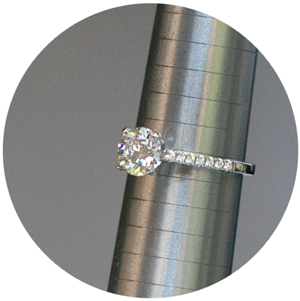
Once all of the quality checks have been completed, each ring is polished using a rotating polishing brush to ensure that it sparkles brilliantly when it is presented. It’s then placed into its box and sent to the customer – ready to create a magical moment and start the next chapter in a couple’s life journey.
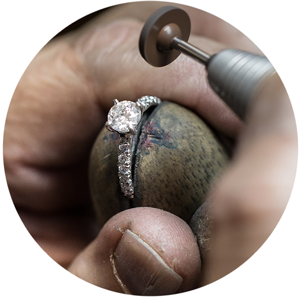
Hopefully this look at how a Blue Nile engagement ring is made has been interesting and useful. Although they produce thousands of rings a year, you can see that great care is taken over each and every one to ensure that it is a fitting center piece to a perfect proposal.
Maybe what’s most incredible to me is how quickly all of this can happen. From clicking ‘buy’ online to a custom ring being distributed can take less than 24 hours – pretty amazing!

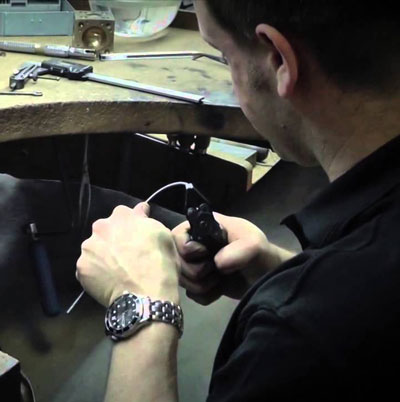
What an awesome article! I never knew that so much went into building a ring! I think it’s great that Blue Nile custom makes each one as it’s ordered, that makes it very personal and special.